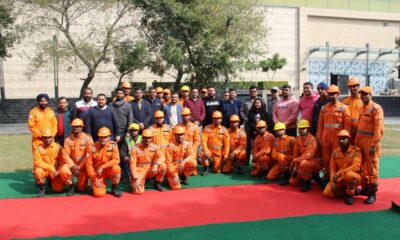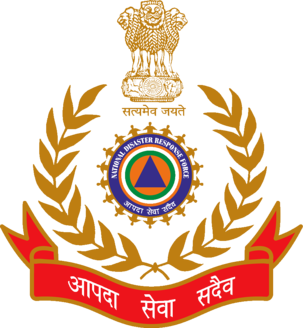Interviews
Developers’ role vital in minimising damage from earthquakes: NDRF Chief
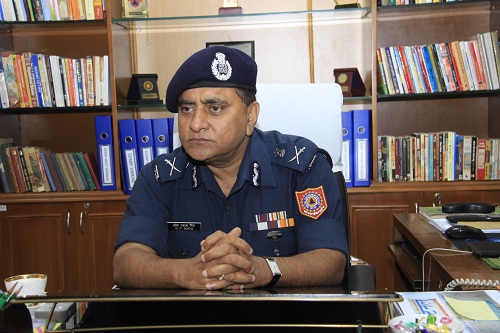

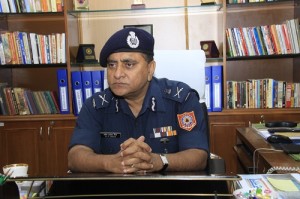

PR. The entire country Is proud of the exemplary work done by NDRF In quake-hit Nepal. What are the lessons learned from the operations?
OP. It’s an ongoing dynamic process. We need to analyse first and then talk about lessons. Right now, it is rather too early. We returned a couple of days back and are trying to get our report ready. Then. we will analyse the various situations – where were the fault lines. where were the rescue operations slightly deficient, what are the areas we need to plug holes? which are the operational areas we need to ensure in a better fashion, logistics. communications all these areas need a certain kind of treatment. We will analyse all these things in due course of time.
PR. How much time do you think the entire rehabilitation process will take In Nepal?
OP. It is very difficult to say because rehabilitation and recovery take a lot of time. But at the same time, I can say that I’m not concerned with rehabilitation. I was only concerned with the rescue work. So it will be premature and improper for me to comment on that. Still. I think everybody is doing their best and hopefully, it will be done in the quickest possible time.
PR. If something like this happens In India. how prepared are we?
OP. In India, we have a great advantage because we have the institutional mechanism at various places. At the national level, we have the National Disaster Management Authority (NDMA) which is chaired by the Prime Minister. Then we also have a very vibrant force that is multi-tasked. multi-skilled and hi-tech in the form of the National Disaster Response Force (NDRF). which I am heading at the moment. Because of these two institutions. the state of preparedness is large.
You have the NDMA which makes the policy, issues the guidelines and you have a very vibrant force in the name of NDRF which not only trains the people, not only trains the community at large but which also caters to the responses in terms of its own presence. We have two important principles which we keep in mind – one is the pre-positioning of NDRF. We always pre-position our forces whenever we have an impending disaster, for example, if we get information that a particular state is going to get affected by a flood, then we certainly try to send our team without any concurrence, without any request from anyone. We go and get ourselves pre-positioned.
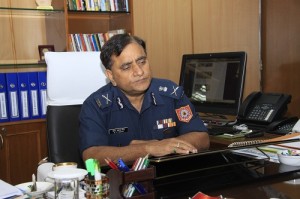

year when we had the information of impending flood, we pre-positioned our teams and surprisingly and by God’s grace nothing happened. But had anything happened, my force would have responded with much alacrity and much efficiency. So that is the reason why the response by NDRF is very good.
• In India, we have a great advantage because we have the institutional mechanism at various places. At the national level, we have the National Disaster Management Authority which is chaired by the Prime Minister. Then we also have a very vibrant force that is multi-tasked, multi-skilled and hi-tech in the form of the National Disaster Response Force.
• We have two important principles which we keep in mind one is the prepositioning of NDRF. We always pre-position our forces whenever you have an impending disaster…At the same time, we have a second principle in place that we also go for proactive deployment.
PR. What difficulties did you face during the rescue operations?
OP. We were the first to reach there. Our Prime Minister immediately took a decision that India needs to help Nepal. As a result, relief was sent to that country within no time.
And this has happened for the first time, perhaps maybe in the world, that an international team of more than 300 people landed in a foreign land, in Kathmandu within six hours of this tragedy. The earthquake struck around 12’0 clock, and we were there by 6 in the evening. By 9-9.30, seven teams were scattered in various parts of Nepal and were busy doing the rescue work. This is no mean achievement!
We have done it for the first time at an international border, though we have gone earlier also, in 2011, to Japan, but this was our first international exposure so far as earthquake is concerned. We landed there, we got the briefing by the Nepalese Army, we were given the
areas of responsibility, we were fanned out to various locations in Kathmandu Valley, we conducted our operations without wasting our time, and we rescued seven people live from the rubbles within the first 12 hours, which is a great achievement by any international standard.
At the same time, when we started our operations, we had two big challenges, which were difficult to manage – the first was that even after an earthquake of huge intensity, we experienced fresh tremors for another few days, which were making the partially damaged buildings unsafe. So when the jawans of NDRF were working in the partially damaged buildings, they were at risk. But they were brave enough, they disregarded the safety of their own lives and continued working in partially damaged buildings. Fortunately enough, nothing happened to them.
The second challenge was in the form of incessant rain. On the second and third day, there was rain and because of this, our operations had to be suspended for some time. That delayed the operations. Perhaps we would have rescued many more people’s lives had rains not disrupted our operations at night as well as in the daytime.
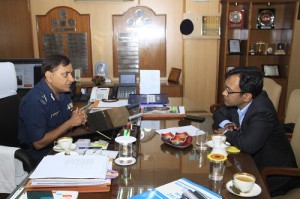

OP.So far as the state of preparedness is concerned, we are second to none. We are a very well-trained force. But certainly, you always have the scope for improvement. For example, about ten years back, when we had the Bhuj earthquake in 2001, everything was done manually. We were not trained. In fact, at that time there was no force like the NDRF, there was no institution like the NDMA. All this thinking started only after that. We became proactive and we became holistic in our approach. We shifted our approach from relief-centric to response-centric.
But in 2001 in the Bhuj earthquake, everything was done manually. We used to use our hands to pull out the bodies, to pull out the live victims, but nowadays everything is technology-driven. We have important equipment. We have the equipment to hear the noise and the sound of the trapped people. We have the equipment to locate the victims inside the buildings, inside the collapsed structures. At the same time, we have equipment like cutters and spreaders, which can cut the iron sheets, concrete, wooden floors and other things. So, all these technologies have contributed a lot towards the efficiency and efficacy of the force like ours.
• The earthquake struck around 12’0 clock, and we were there by 6 in the evening. By 99.30, seven teams were scattered in various parts of Nepal and were busy doing the rescue work. This is no mean achievement!
• We had two big challenges, which were difficult to manage-the first was that even after an earthquake of huge intensity, we experienced fresh tremors for another few days, which were making the partially damaged buildings unsafe…The second challenge was in the form of incessant rain.
PR. Real estate suffers the maximum damage during such disasters. What precautionary measures do you think the sector needs to take?
OP. This is a very important issue because ultimately it is the real estate sector that has to take preventive measures. An earthquake cannot be predicted but you can certainly minimise the damage. You can minimise the effects of an earthquake. The first is the land-use policy, which is very important. Which are the areas which are more vulnerable, which are the core areas which are likely to have earthquakes of such kind, you have to identify. You have gone for hazard-zoning, you have to go for assessment of such buildings, assessment of such areas. Then after that, you need to have a policy in place where the real estate sector can play a very significant and positive role because in earthquakes you have structural and nonstructural dimensions. While the structural dimensions keep you telling that you need to observe the National Building Code, there has to be strict monitoring of this.
In Nepal, we saw that all those buildings which were weak in character, which were weak in structure, collapsed. Three kinds of patterns I saw there – one is the entire structure falling in a pancake fashion where the layers fell off to another layer, then there were buildings which collapsed in a tilted form, they tilted and fell on to the other building. The third was where there was a ‘V’-shaped deformation where the roofs were not so strong and there were cracks within the roofs. So the middle of the roof cracked fell because of that and formed a V-shaped structure.
All these point to faulty construction mechanisms.
So, real estate has to play a very important role. They have to see what kind of structures they have to be built, whether the structures
are earthquake-resistant or not. In the case of old buildings, they need to be retrofitted all the time. So the construction and real estate sectors have to play a very important role in minimising the consequence of earthquakes. They are the ones who can go for a very effective construction, they have to use standard material, they have to use the standard procedures, then only you can minimise the damage.
PR. But doesn’t the Government also need to ensure proper monitoring of the guidelines?
OP. Absolutely! The Government has an even bigger role to play and it is doing its best. Various guidelines have been issued by the NOMA. Even at the Government of India level, there have been laws. There have been rules and regulations not only for real estate but for all industries. For example chemical industry – we have the problem of CBRN (Chemical Biological Nuclear Energy). A lot of damage is done through gas leakage.
We had the Bhopal gas tragedy way back in 1984.
Similarly, you have the possibility of CBRN emergencies also. Not only earthquake, not only flood, but you also have all these kinds of disasters which can take place in a huge country like India
India is very vulnerable to all disasters. You have almost 58 percent land mass vulnerable to earthquakes,you have so many million
hectares vulnerable to floods. The coastal states are very vulnerable to cyclones. All these things have to be taken into account. Rules are in place, the laws have been made, the guidelines have been issued, but the strict implementation of the guidelines is required. On top of it, you need to have a
mechanism by which you can monitor those things, and that is needed at the Government level, at the society level.
• Nowadays everything is technology-driven. We have important equipment. We have the equipment to hear the noise and the sound of the trapped people. We have the equipment to locate the victims inside the buildings, inside the collapsed structures. At the same time, we have equipment like cutters and spreaders.
PR. After the recent tragedy, there have been talks of a ‘Saarc response centre’. What is the status of that? If and when it is formed, how beneficial do you think it would be?
OP. Certainly, it will be beneficial. Because, the countries like Nepal, Bhutan, or Sri Lanka to some extent have to enhance their capacity-building. India has also to enhance its capacity-building in terms of tackling natural and man-made disasters.
Recently we had a meeting in Indonesia, which was conducted by the Saarc Development Disaster Management Council (SDMC), where I was the representative of the Government of India along with Secretary, NDMA. There was a provision, just like the Asian countries have the regional response center in Indonesia, similarly, we need to have a regional response centre in Delhi where we can have not only the resources for all the eight countries but also we should have the mechanism
We can cooperate which each other so far as the training is concerned, we can train them.
Say, for example, NDRF can train personnel from Pakistan, Nepal, Bhutan, and the Maldives. All these countries require a lot of training to tackle natural man-made disasters, and India is in a position to train these people and thereby we can have regional, bilateral cooperation, so far as disaster management is concerned.
Disaster is something that is worldwide. In India, we are losing almost $9.8 billion per year on average, out of which $7 billion is because of floods. So, we need to tackle these, because disaster is linked to development. Disaster cannot be treated in isolation, and that is why we talk about sustainable development which can only be achieved, when you can talk of, and link disaster with development. So these two should go together
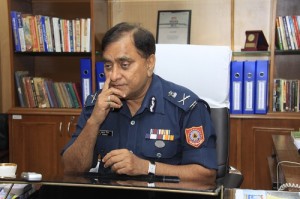

OP. Certainly! This is a very valid issue. We have ten battalions of NDRF spread all over the country. Recently, the Government sanctioned two more. So we are going to be 12 battalions spread all over. Apart from these 12 battalions about which the locations have been identified based on the vulnerability profile of the country, we have 23 regional response centers. They are fanned overall across the country. But we need to have many more battalions. We need to have many more regional response centers in order to strengthen the institutional response mechanism of NDRF.
Not only that, even the states have to strengthen their own institutional mechanism. All the states need to develop their own state disaster response force. Many states have done it but some are lagging behind. They need to create their own force because NDRF cannot be the first responder. Only the society or the community has to be the first responder. Even in Nepal, we reached within six hours, not six minutes, even the police and the paramilitary forces of Nepal have to be dependent on the community they serve, so the community is always the first responder.
So not only the NDRF, the state disaster response force has to be created and strengthened. Apart from that, community awareness programmes should be conducted. In fact, NDRF does lot of community training. We have so far trained 40 lakh people all over the country. We conduct
training, workshops, seminars, mock drills and conduct joint operations with the help of all the stakeholders.
The whole nation has to be trained for disasters, and unless you have the consciousness at the national, state and community level, you will not be able to minimise the effects of a disaster. Each city needs to prepare itself. When we talk of safe cities, safety comprises disaster management as well. When you talk of safety it is not only civil safety, you are talking of disaster safety as well. Only then, your city can be a smart city!
• real estate has to play a very important role. They have to see what kind of structures they have to build, whether the structures are earthquake resistant or not. In case of old buildings, they need to be retrofitted all the time. So the construction and real estate sectors have to play a very important role in minimising the consequence of earthquakes.
• The Government has an even bigger role to play and it is doing its best. Various guidelines have been issued by the NDMA. Even at the Government of India- level, there have been laws. There have been rules and regulations not only for real estate but for all industries.
• NDRF can train personnel from Pakistan, Nepal, Bhutan, and the Maldives. All these countries require a lot of training to tackle natural man-made disasters, and India is in a position to train these people and thereby we can have regional, bilateral cooperation, so far as disaster management is concerned.
• The whole nation has to be trained for disasters, and unless you have the consciousness at the national, state and community level, you will not be able to minimise the effects of a disaster. Each city needs to prepare itself. When we talk of safe cities, safety comprises disaster management as well.
-



 Interviews4 weeks ago
Interviews4 weeks agoHigh Rental Yield, Price Appreciation, Stable Growth, Make Sydney an Ideal Realty Investment Option: Haansal Estate
-



 News3 weeks ago
News3 weeks agoKW Delhi 6 Mall Onboards New Brands
-



 News3 weeks ago
News3 weeks agoManasum Senior Living Launches IKIGAI GOA, A Senior Living Community in North Goa, in collaboration with Prescon Homes
-



 News2 weeks ago
News2 weeks agoGodrej Properties Sells Rs 3k cr+ Homes of Godrej Zenith, Gurugram, within 3 days
-



 News3 weeks ago
News3 weeks agoBridging India Divide: Top 5 Tier- 2 Cities to Focus On
-



 News3 weeks ago
News3 weeks agoCommercial Realty Gets Tech Savvy: Fast Construction, Enhanced Convenience
-



 News3 weeks ago
News3 weeks agoMultipoint Connection – A Definite Boon
-



 News2 weeks ago
News2 weeks agoRBI’s Status Quo on Key Policy Rates to Help Maintain the Real Estate Growth Momentum, Say Industry Stalwarts







